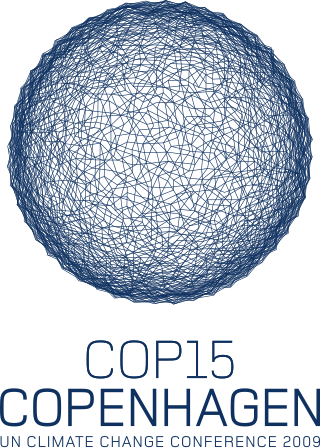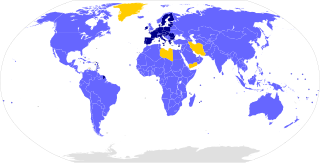Related Research Articles

The Kyoto Protocol (Japanese: 京都議定書, Hepburn: Kyōto Giteisho) was an international treaty which extended the 1992 United Nations Framework Convention on Climate Change (UNFCCC) that commits state parties to reduce greenhouse gas emissions, based on the scientific consensus that global warming is occurring and that human-made CO2 emissions are driving it. The Kyoto Protocol was adopted in Kyoto, Japan, on 11 December 1997 and entered into force on 16 February 2005. There were 192 parties (Canada withdrew from the protocol, effective December 2012) to the Protocol in 2020.
The United Nations Framework Convention on Climate Change (UNFCCC) established an international environmental treaty to combat "dangerous human interference with the climate system", in part by stabilizing greenhouse gas concentrations in the atmosphere. It was signed by 154 states at the United Nations Conference on Environment and Development (UNCED), informally known as the Earth Summit, held in Rio de Janeiro from 3 to 14 June 1992. Its original secretariat was in Geneva but relocated to Bonn in 1996. It entered into force on 21 March 1994.
Post-Kyoto negotiations refers to high level talks attempting to address global warming by limiting greenhouse gas emissions. Generally part of the United Nations Framework Convention on Climate Change (UNFCCC), these talks concern the period after the first "commitment period" of the Kyoto Protocol, which expired at the end of 2012. Negotiations have been mandated by the adoption of the Bali Road Map and Decision 1/CP.13.
After the 2007 United Nations Climate Change Conference held on the island of Bali in Indonesia in December 2007, the participating nations adopted the Bali Road Map as a two-year process working towards finalizing a binding agreement at the 2009 United Nations Climate Change Conference in Copenhagen, Denmark. The conference encompassed meetings of several bodies, including the 13th session of the Conference of the Parties to the United Nations Framework Convention on Climate Change and the third session of the Conference of the Parties serving as the meeting of the Parties to the Kyoto Protocol.

The 2009 United Nations Climate Change Conference, commonly known as the Copenhagen Summit, was held at the Bella Center in Copenhagen, Denmark, between 7 and 18 December. The conference included the 15th session of the Conference of the Parties to the United Nations Framework Convention on Climate Change (UNFCCC) and the 5th session of the Conference of the Parties serving as the Meeting of the Parties to the Kyoto Protocol. According to the Bali Road Map, a framework for climate change mitigation beyond 2012 was to be agreed there.

The 2008 United Nations Climate Change Conference took place at PIF Congress Centre, Poznań International Fair (PIF), in Poznań, Poland, between December 1 and December 12, 2008. Representatives from over 180 countries attended along with observers from intergovernmental and nongovernmental organizations.

The Major Economies Forum on Energy and Climate (MEF) was launched on March 28, 2009. The MEF is intended to facilitate a candid dialogue among major developed and developing economies, help generate the political leadership necessary to achieve a successful outcome at the December UN climate change conference in Copenhagen, and advance the exploration of concrete initiatives and joint ventures that increase the supply of clean energy while cutting greenhouse gas emissions. Denmark, in its capacity as the President of the December 2009 Conference of the Parties to the UN Framework Convention on Climate Change, and the United Nations have also participated in this dialogue along with Observers.

Climate debt is the debt said to be owed to developing countries by developed countries for the damage caused by their disproportionately large contributions to climate change. Historical global greenhouse gas emissions, largely by developed countries, pose significant threats to developing countries, who are less able to deal with climate change's negative effects. Therefore, some consider developed countries to owe a debt to developing ones for their disproportionate contributions to climate change.
The Copenhagen Accord is a document which delegates at the 15th session of the Conference of Parties to the United Nations Framework Convention on Climate Change agreed to "take note of" at the final plenary on 18 December 2009.

The 2010 United Nations Climate Change Conference was held in Cancún, Mexico, from 29 November to 10 December 2010. The conference is officially referred to as the 16th session of the Conference of the Parties (COP 16) to the United Nations Framework Convention on Climate Change (UNFCCC) and the 6th session of the Conference of the Parties serving as the meeting of the Parties (CMP 6) to the Kyoto Protocol. In addition, the two permanent subsidiary bodies of the UNFCCC — the Subsidiary Body for Scientific and Technological Advice (SBSTA) and the Subsidiary Body for Implementation (SBI) — held their 33rd sessions. The 2009 United Nations Climate Change Conference extended the mandates of the two temporary subsidiary bodies, the Ad Hoc Working Group on Further Commitments for Annex I Parties under the Kyoto Protocol (AWG-KP) and the Ad Hoc Working Group on Long-term Cooperative Action under the Convention (AWG-LCA), and they met as well.

The Paris Agreement, often referred to as the Paris Accords or the Paris Climate Accords, is an international treaty on climate change. Adopted in 2015, the agreement covers climate change mitigation, adaptation, and finance. The Paris Agreement was negotiated by 196 parties at the 2015 United Nations Climate Change Conference near Paris, France. As of February 2023, 195 members of the United Nations Framework Convention on Climate Change (UNFCCC) are parties to the agreement. Of the three UNFCCC member states which have not ratified the agreement, the only major emitter is Iran. The United States withdrew from the agreement in 2020, but rejoined in 2021.

The United Nations Climate Change Conferences are yearly conferences held in the framework of the United Nations Framework Convention on Climate Change (UNFCCC). They serve as the formal meeting of the UNFCCC parties to assess progress in dealing with climate change, and beginning in the mid-1990s, to negotiate the Kyoto Protocol to establish legally binding obligations for developed countries to reduce their greenhouse gas emissions. Starting in 2005 the conferences have also served as the "Conference of the Parties Serving as the Meeting of Parties to the Kyoto Protocol" (CMP); also parties to the convention that are not parties to the protocol can participate in protocol-related meetings as observers. From 2011 to 2015 the meetings were used to negotiate the Paris Agreement as part of the Durban platform, which created a general path towards climate action. Any final text of a COP must be agreed by consensus.

A nationally determined contribution (NDC) or intended nationally determined contribution (INDC) is a non-binding national plan highlighting climate change mitigation, including climate-related targets for greenhouse gas emission reductions. These plans also include policies and measures governments aim to implement in response to climate change and as a contribution to achieve the global targets set out in the Paris Agreement.

The 2016 United Nations Climate Change Conference was an international meeting of political leaders and activists to discuss environmental issues. It was held in Marrakech, Morocco, on 7–18 November 2016. The conference incorporated the twenty-second Conference of the Parties (COP22), the twelfth meeting of the parties to the Kyoto Protocol (CMP12), and the first meeting of the parties to the Paris Agreement (CMA1). The purpose of the conference was to discuss and implement plans about combatting climate change and to "[demonstrate] to the world that the implementation of the Paris Agreement is underway". Participants work together to come up with global solutions to climate change.
Article 6 of the Paris Agreement on climate change enables Parties to cooperate in implementing their nationally determined contributions (NDCs). Among other things, this means that emission reductions can be transferred between countries and counted towards NDCs. Agreement on the provisions of Article 6 was reached after intensive negotiations lasting several years.
The history of climate change policy and politics refers to the continuing history of political actions, policies, trends, controversies and activist efforts as they pertain to the issue of climate change. Climate change emerged as a political issue in the 1970s, where activist and formal efforts were taken to ensure environmental crises were addressed on a global scale. International policy regarding climate change has focused on cooperation and the establishment of international guidelines to address global warming. The United Nations Framework Convention on Climate Change (UNFCCC) is a largely accepted international agreement that has continuously developed to meet new challenges. Domestic policy on climate change has focused on both establishing internal measures to reduce greenhouse gas emissions and incorporating international guidelines into domestic law.

Pledge and review is a method for facilitating international action against climate change. It involves nations each making a self-determined pledge relating to actions they expect to take in response to global warming, which they submit to the United Nations. Some time after the pledges have been submitted, there is a review process where nations assess each other's progress towards meeting the pledges. Then a further round of enhanced pledges can be made, and the process can further iterate.

REDD+ is a framework to encourage developing countries to reduce emissions and enhance removals of greenhouse gases through a variety of forest management options, and to provide technical and financial support for these efforts. The acronym refers to "reducing emissions from deforestation and forest degradation in developing countries, and the role of conservation, sustainable management of forests, and enhancement of forest carbon stocks in developing countries". REDD+ is a voluntary climate change mitigation framework developed by the United Nations Framework Convention on Climate Change (UNFCCC). REDD originally referred to "reducing emissions from deforestation in developing countries", which was the title of the original document on REDD. It was superseded by REDD+ in the Warsaw Framework on REDD-plus negotiations.
References
- ↑ "The Bali Action Plan : Key Issues in the Climate Negotiations. Summary for Policymakers" (PDF). United Nations Development Programme . 2008. Archived from the original (PDF) on 2010-05-24. Retrieved 2010-04-27.
- ↑ "Targets and Actions under the Copenhagen Accord". C2ES, Center for Climate and Energy Solutions. Archived from the original on 2012-03-22. Retrieved 2012-02-09.
- ↑ "Report of the Conference of the Parties on its fifteenth session, held in Copenhagen from 7 to 19 December 2009. Addendum. Part Two: Action taken by the Conference of the Parties at its fifteenth session" (PDF). UNFCCC International Convention on Climate Change. 2010-03-30. Retrieved 2022-07-30.
- 1 2 Bratasida, Liana (2008). "What is 'nationally appropriate mitigation action'?" (PDF). OECD . Retrieved 2022-07-30.
- ↑ "Government of India Submission to UNFCCC on Nationally Appropriate Mitigation Actions (NAMAs) by developing countries" (PDF). United Nations Climate Change. Retrieved 2022-07-30.
- ↑ Sutter, C; Schibli, R (2011). "If you want a Nama tomorrow, you need a POA today (March 2011)" (PDF). Trading Carbon, Reuters, South Pole Carbon. Archived from the original (PDF) on 2016-03-03.
- ↑ "Harkingbade | Learning Base - Code, Tech, Tutorials, & Startups". 5 January 2018.
- ↑ UNFCCC, 2012 "Submission of more information by developing country Parties, subject to availability, relating to nationally appropriate mitigation actions, including underlying assumptions and methodologies, sectors and gases covered, global warming potential values used, support needs for implementation of nationally appropriate mitigation actions and estimated mitigation outcomes. Submissions from Parties." FCCC/AWGLCA/2012/MISC.2
- ↑ UNFCCC, 2011 "Compilation of information on nationally appropriate mitigation actions to be implemented by Parties not included in Annex I to the Convention." FCCC/AWGLCA/2011/INF.1
- ↑ Nations, United. "NAMAS List" . Retrieved 28 November 2013.
- ↑ Stoft, Steven (2009-10-23). "Beyond Kyoto: Flexible Carbon Pricing for Global Cooperation". Global Energy Policy Center Research Paper. Rochester, NY. 09 (5). doi:10.2139/ssrn.1502944. S2CID 154331431. SSRN 1502944.